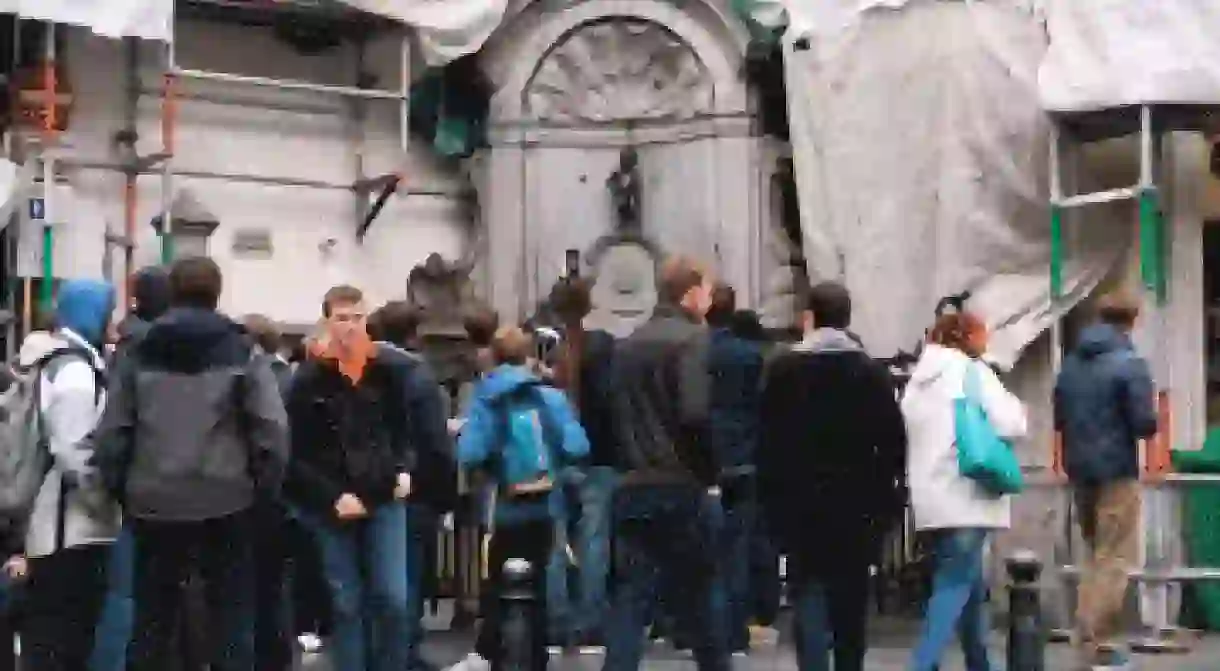Discover Brussels’ Peeing Statues

Centuries ago, the people of Brussels embraced a small, quirky statue of a peeing boy as their symbol to the world. Along with the Atomium, Manneken Pis, with his washboard abs and cherub curls, is the single most recognizable landmark in the capital. After centuries alone, he finally got some company in the 80s and 90s in the form of fellow peeing kid Jeanneke and peeing dog Zinneke, further tokens of a healthy Belgian sense of self-mockery.
Manneken Pis
Once face-to-face with Manneken Pis, ‘Little Peeing Man’ in English or ‘Petit Julien’ by his French name, people are often struck by how small the fellow is ‘in real life.’ Fifty-eight centimeters of bronze standing on a small water basin behind a firm iron-cast gate isn’t exactly what you’d call impressive after seeing many close-ups of the world-famous ‘ketje.’ His size does, however, explain how so many jokers have managed to abduct him over the years. In 1747, Louis XV of France even had to reprimand a group of his grenadiers who thought it was funny to steal the Manneken but unintentionally almost provoked a riot. Realizing the special place the silly statue holds in Brusselaars’ hearts and history (he’d survived the 1695 bombardments that reduced one-third of the capital to rubble), the French monarch returned the Manneken donned in an expensive brocade-and-gold outfit – his second costume ever – to make amends.



The last kidnapping dates back to 1965, upon which a replica was made and placed on the fountain. When the abducted sculpture was found broken in half a year later, it was restored to its full glory and is still kept safe at The Broodhuis, the City Museum on the Grand-Place that doubles as the Manneken’s personal dressing room. The tradition to dress up the toddler in costumes for special occasions dates back to at least the 18th century when a rotation of four outfits a year was customary. By now, so many organizations and befriended countries have gifted the city a customized ensemble for their beloved stone boy that he’s swimming in over 900 sets of clothes, from Red Devil supporter to Uncle Sam to deep sea diver to even a condom meant to raise awareness of STDs. A hundred Manneken replicas show off pieces in the collection at the City Museum.
Corner of Rue de l’Étuve and Rue du Chêne, Brussels, Belgium


Jeanneke Pis
Unlike her brother who was created and put on his pedestal in 1618 or 1619, Jeanneke Pis has only been around since 1987. Located in a small, cobbled alley on the other side of the Grand-Place, she forms the counterpart to Brussels’ Manneken in both location and gender. Legend has it that gentleman Denis-Adrien Debouvrie, a local of the Ilot Sacré quarter, wanted to give back to his neighborhood, preferably ‘something folkloric.’ As the idea struck him and he started doodling the Manneken’s female counterpart, Debouvrie supposedly said: ‘Now we have gender equality.’ Jeanneke is a little harder to find than her brother, squatting behind a red fence in a more tranquil cul-de-sac as she is, yet tracking her down and throwing a coin into the fountain should yield good karma: every penny dropped into the basin goes toward cancer research.
Impasse de la Fidélité, Brussels, Belgium


Zinneke
The third and youngest member of Brussels’ peeing statue family is one we’re more used to seeing relieve himself in public; it’s man’s best friend. Zinneke – sometimes mistakingly called Zinneke Pis – is the hardest one to find, and chances are you’ll look past him at first glance, believing he’s an actual dog doing his business against a small pole, as dogs do. Upon closer inspection, though, this particular pooch isn’t letting it flow; unlike his owners, he’s not a fountain. Once discovered, the least known of the pissing sculptures often becomes his visitors’ personal favorite, and he is a great way to get to know the character of the city. Aside from pointing out the typically Belgian humor of making a pissing dog a key tourist attraction, his name refers to the melting pot label the metropolis wears with pride: ‘Zinneke’ is the word used for a Brusselaar of mixed origins. Last but not least, the pup is free of any fences, making him the most fun to take pictures of – especially when copying his pose, as many visitors do.
Corner of the Rue des Chartreux and Rue du Vieux Marché, Brussels, Belgium















